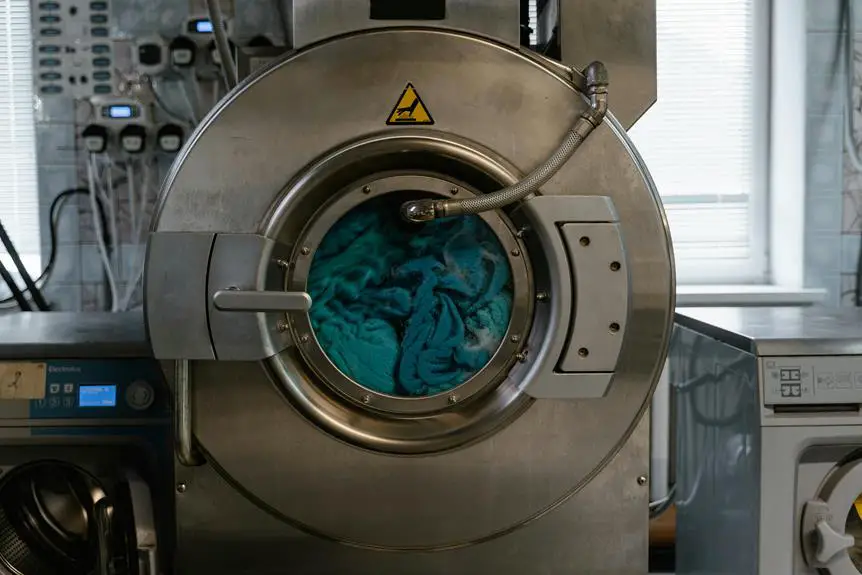When you're preparing to acid wash fabrics, it's crucial to understand the type of material you're working with to avoid unintended damage. Check the care labels for guidance, and don't forget to set up protective barriers like plastic sheeting to contain any spills. You'll want to choose your acid solutions carefully, starting with milder options like vinegar for delicate fabrics. But before you jump in, there are essential steps you might overlook that can make a significant difference in the outcome. What might those steps be, and how can they protect your fabrics more effectively?
Table of Contents
Key Takeaways
- Always check care labels for fabric composition to ensure compatibility with acid washing methods.
- Use protective barriers like plastic sheeting and old towels to contain spills and splashes.
- Opt for diluted vinegar or lemon juice for safer acid solutions, especially on cotton and denim.
- Test any acid solution on a small area first to assess potential damage before full application.
Understand Fabric Types
To effectively protect your fabrics during acid washing, you should first understand the different types of materials you'll be working with. Each fabric reacts differently to acids, so knowing what's in your collection is crucial.
Cotton, for example, is a popular choice for acid washing due to its durability. It can hold up well against acids but may still lose some color or texture if not handled correctly.
On the other hand, synthetic fabrics like polyester may not react as dramatically but can melt or warp if the acid concentration is too high.
Natural fibers such as linen or silk require extra caution. While linen can withstand some acid treatments, silk is delicate and can easily become damaged.
It's essential to check the care labels on your fabrics to identify their composition and potential vulnerabilities.
Pre-Wash Fabric Preparation
Preparing your fabrics before washing is essential for ensuring they withstand the acid treatment without damage. Start by checking the care labels on your fabrics. This gives you crucial information about their composition and any specific washing instructions.
If you're dealing with delicate materials like silk or wool, handle them with extra care, as they can be particularly sensitive to acid.
Next, give your fabrics a good shake to remove any dust or debris. If they're heavily soiled, consider pre-soaking them in cold water for about 30 minutes. This helps loosen dirt and grime, making the acid wash more effective. Make sure not to use hot water, as it can set stains and damage some fabrics.
If you have multiple pieces, sort them by color and fabric type. This step prevents dye transfer during the acid wash. For items like denim, you might want to turn them inside out to minimize surface abrasion.
Use Protective Barriers
Using protective barriers can significantly reduce the risk of damage to your fabrics during the acid washing process. These barriers help shield your materials from harsh chemicals, ensuring they remain intact and vibrant.
Here are a few effective options you should consider:
- Plastic Sheeting: Lay down plastic sheeting over surfaces where you'll be working. This prevents acid spills from reaching your fabrics and helps contain any splashes.
- Old Towels or Rags: Use old towels or rags to cover areas where you may accidentally drip acid. They absorb spills and provide an extra layer of protection for your fabrics.
Choose Appropriate Acid Solutions
Choosing the right acid solutions is crucial for achieving the desired effects without damaging your fabrics. Different fabrics react differently to various acids, so it's essential to select solutions that are safe for your specific materials. For instance, diluted vinegar or lemon juice can work wonders on cotton and denim, providing a mild effect that won't harm the fibers.
On the other hand, stronger acids like hydrochloric acid or sulfuric acid can severely damage delicate fabrics, such as silk or wool. Always read labels and choose products specifically designed for fabric treatment.
If you're ever in doubt, it's better to start with a weaker solution and test it on a small, inconspicuous area first.
Post-Wash Care Tips
After acid washing, it's essential to rinse your fabrics thoroughly to remove any residual acid that could weaken the fibers. A good rinse ensures your materials remain strong and vibrant.
Once you finish rinsing, it's time to give your fabrics some extra care.
Here are a few post-wash care tips to keep in mind:
- Dry Properly: Hang your fabrics to dry in a shaded area. Direct sunlight can fade colors and weaken fibers over time.
- Avoid Harsh Detergents: Use mild detergents when washing your fabrics again. Harsh chemicals can damage the fibers that have already been exposed to acid.
Frequently Asked Questions
Can I Acid Wash Delicate Fabrics Like Silk or Chiffon?
You can't acid wash delicate fabrics like silk or chiffon. The harsh chemicals can damage their fibers, causing discoloration or weakening. It's best to avoid acid washing these materials to keep them looking their best.
How Do I Know if a Fabric Is Colorfast?
To determine if a fabric's colorfast, you can do a simple test. Dampen a small, hidden area with water and blot it with a white cloth. If color transfers, it's not colorfast.
What Should I Do if My Fabric Gets Damaged During Acid Washing?
If your fabric gets damaged during acid washing, assess the extent of the damage. You might try repairing small tears or stains with fabric glue or dye. If it's beyond repair, consider replacing it.
Is It Safe to Acid Wash Vintage or Antique Fabrics?
Acid washing vintage or antique fabrics isn't safe. The chemicals can weaken fibers and cause irreversible damage. Always test a small area first, or consult a professional to preserve the integrity of your treasured items.
Can I Mix Different Fabrics in One Acid Wash?
You shouldn't mix different fabrics in one acid wash. Each fabric reacts differently to acids, which can lead to uneven results or damage. It's best to wash similar fabrics together for consistent outcomes.
- Calico for Quilting: Why It’s a Popular Choice for Crafters - June 19, 2025
- Your Guide to Buying Cheap Calico Fabric Without Sacrificing Quality - June 19, 2025
- Is Keepsake Calico Fabric From JOANN 100% Cotton? - June 19, 2025







